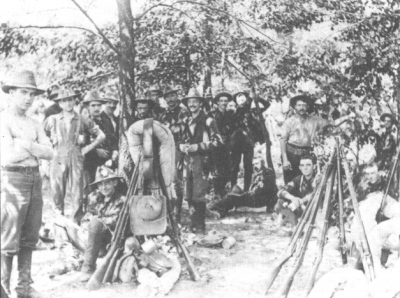1898-1899

4th Kentucky in Camp. Photo Courtesy Russell Brothers and Alabama Room Collection, Public Library of Anniston and Calhoun County, Anniston, Ala.
Inspired by the rabble-rousing yellow journalism of Hearst and Pulitzer, Americans were ready to commit troops to Cuba. The sinking of the USS MAINE and her 266 men provided such a catalyst to enter a war with Spain. The Kentucky National Guard was quickly brought up to full strength. Drilling increased and when it was determined that there was a lack of finances to fund the men of the Kentucky National Guard, private citizens made contributions. Mustering activities took place primarily around Lexington and when the Kentucky contingent was ready, it was shipped to Chickamauga, Tennessee, to be attached to Federal forces. Four Infantry regiments and two Cavalry troops of the Kentucky State Guard (5,595 volunteers) participated in one way or another. However, during this relatively short war, the Kentucky Militia did not engage in any actual combat. The First Regiment (Louisville Legion), commanded by Colonel John B. Castleman, arrived in Puerto Rico as the final shots of the war were fired. The Legion served as reinforcements and performed security, police and courier duties. Colonel Castleman served as military governor of the city of Ponce. In 1899 the Kentucky Guard units were mustered out of Federal service. On record six thousand sixty-five Kentucky soldiers participated in the various campaigns in Cuba, Puerto Rico, and the Philippines, suffering 89 casualties. Once more the Kentucky Guardsmen proved that, if properly led and disciplined, they were worthy on land or sea.
Additional Resources